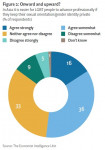The rally in raw materials prices will not be sustained, says Economist Intelligence Unit
Prices were supported in the first half of 2009 by a return of investor risk appetite, fuelled by optimism about economic recovery and financed by massive fiscal and monetary easing across the global economy. Markets chose to ignore data showing the steady accumulation of stocks and weak demand. Rising prices also led to consumer hedging (creating demand in the market) due to concerns about further price rises. Meanwhile, the US dollar exchange rate continued to have an impact in the markets, with its relative weakness contributing to the rise in prices. And finally, a marked contango, or premium in forward prices, encouraged speculative physical buying and storage for later sale.
We expect consumption to pick up in the second half of the year, partly owing to some stockbuilding but also to the beneficial impact of fiscal stimulus. However, the Economist Intelligence Unit believes this positive development has already been more than factored into prices.
Within the industrial raw materials (IRM) index, average annual base metal prices are expected to fall by 38% in 2009, with only a modest recovery of 11% in 2010. Stocks, which had been at historically low levels in 2006-08, will build, but lower output will prevent a massive accumulation. Rubber prices are also expected to suffer because of lower demand from the auto sector and the fall in price of synthetic rubber (in line with lower oil prices). Cotton prices will be weak, but will be supported by sharply lower supply.
In 2010-11 we expect a limited rebound in the prices of most industrial raw materials. Although we expect some recovery in the global economy, the growth in consumption will not be sufficient to create supply bottlenecks. However, concerns about long-term supply could resurface in 2011, particularly as investment in the raw materials sector will be scaled back in 2009-10 in the wake of lower prices, weak demand and less accessible financing. Capacity closures in 2009 may also become permanent if demand fails to pick up markedly.
The IRM index accounts for about 44% of the Economist Intelligence Unit's world commodity forecasts (WCF) index, the remainder being accounted for by soft commodities. The prices of soft commodities are also expected to be weak in 2009 but they are not so closely linked to the business cycle and thus the WCF index is expected to fall by 27% in 2009, before rising by just 6.5% in 2010.
Crude oil
The oil price is expected to be weak in 2009-10. (Crude oil, owing to its large size, is not included in the IRM index.) Consumption is expected to contract for the second consecutive year, by 2.6% in 2009, before rising by a modest 1.2% in 2010. Production will also be lower, owing to OPEC production constraints and disappointing growth in non-OPEC supply, but this will only put a floor under prices. Ample spare capacity in OPEC producers will limit the scope for prices to rise significantly. A number of key geopolitical risks could disrupt supply, but are unlikely to have a long-term impact on prices given comfortable stock levels. Despite poor market fundamentals, liquidity has been entering the oil market, premised on expectations of strong economic recovery. A more sanguine expectation of growth prospects in the second half will stabilise prices at around US$60/barrel in 2009, before rising slightly to US$65/b in 2010.
For specific commodities, the Economist Intelligence Unit’s current forecasts are as follows:
Overview: Prices have risen more strongly than expected in the second quarter of 2009, due to optimism about a rapid turnaround in the global economy and some return of investor risk appetite. Prices will stabilise at a lower level in the second half of 2009 and rise only modestly in 2010 in tandem with only a gradual recovery in demand. The Economist Intelligence Unit's IRM index is forecast to fall by 35% in 2009, relative to 2008, and to rise by just 13% in 2010.
Aluminium: A rapid response by the industry to the downturn in demand has led us to revise up our price forecasts. However, prices will remain relatively weak in 2010.
Copper: Prices are expected to start rising in 2010, reflecting low inventories throughout the supply chain, mine production shortfalls, a dearth of major next-generation projects, smelter production cutbacks, scrap market tightness and stockpiling in China.
Crude oil: Growth in consumption is forecast to remain subdued in 2010. This, together with ample spare capacity in OPEC-producing countries, suggests there will be only modest upward pressure on prices next year.
Fibres: Persistent falls in cotton output will provide a floor under prices in 2009 and enable prices to rise in 2010 in tandem with some recovery in consumption. Wool prices will rise in 2010, owing to falling stocks.
Lead: Prices rallied in the second quarter of 2009 despite poor market fundamentals, suggesting the gains might be difficult to sustain. We expect prices to recover strongly in the second half of 2010 as demand picks up.
Natural rubber: The collapse in the global automotive sector and the fall in the price of oil (a key input in synthetic rubber) have depressed demand for natural rubber. We expect the price to rise in 2010 in tandem with the crude oil price.
Nickel: A gradual recovery in demand from the second half of 2009 will mean that prices will rise gently in 2010.
Tin: The price rose strongly in the second quarter, despite weak demand and rising stocks. We expect the price to fall back, before stronger demand in 2010 supports a price increase.
Zinc: Lower mine output and smelter cutbacks mean that zinc stocks have remained low, despite weak demand. This will support prices in the medium term.
World commodity forecasts: industrial raw materials July 2009
Notes for editors:
World commodity forecasts is published quarterly in two volumes, providing expert analysis and forecasts on 25 commodities. One volume, Food, feedstuffs and beverages, covers the four key soft commodity groups: beverages, grains, oilseeds and sugar. A second volume, Industrial raw materials, analyses the four key hard commodity groups: base metals, natural fibres, rubber and crude oil.
About the Economist Intelligence Unit
The Economist Intelligence Unit is the business information arm of The Economist Group, publisher of The Economist. Through our global network of more than 650 analysts and contributors, we continuously assess and forecast political, economic and business conditions in 200 countries. As the world's leading provider of country intelligence, we help executives make better business decisions by providing timely, reliable and impartial analysis on worldwide market trends and business strategies.
웹사이트: http://www.eiu.com
연락처
Joanne McKenna
+44 (0)20 7576 8188
이메일 보내기
이 보도자료는 Economist Intelligence Unit가(이) 작성해 뉴스와이어 서비스를 통해 배포한 뉴스입니다. 뉴스와이어는 편집 가이드라인을 준수합니다.




